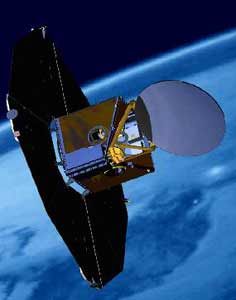
Home - Search - Browse - Alphabetic Index: 0- 1- 2- 3- 4- 5- 6- 7- 8- 9
A- B- C- D- E- F- G- H- I- J- K- L- M- N- O- P- Q- R- S- T- U- V- W- X- Y- Z
Odin
 Odin Credit: Manufacturer Image |
Status: Operational 2001. First Launch: 2001-02-20. Last Launch: 2001-02-20. Number: 1 . Gross mass: 250 kg (550 lb).
It carried a cryogenic radiometer to monitor three millimeter-bands at 118.25-119.25, 486.1-503.9, and 541.0-580.4 GHz, at a resolution of 0.1-1.0 MHz. It carried also a cryogenic optical spectrometer to cover three visible and infrared bands at 280-800 nm, and another infrared band at 1,270 nm. The target gases of astrophysical interest were carbon iodide (CI), water vapor, hydrogen sulfide, ammonia and a few others. For atmospheric studies, the gases were chlorine monoxide, nitrous oxide, nitrogen dioxide, hydrogen peroxide, nitrous oxide, nitric acid, and a few others. Both instruments were fed by a 1.1 meter Gregorian telescope.
Electric System: 0.34 average kW.
More at: Odin.
Family: Astronomy, Infrared astronomy satellite. Country: Sweden. Launch Vehicles: Topol', Start-1. Launch Sites: Svobodniy, Svobodniy LC5. Agency: SSC. Bibliography: 2, 296, 552, 554, 6744, 12898.
2001 February 20 - . 08:48 GMT - . Launch Site: Svobodniy. Launch Complex: Svobodniy LC5. LV Family: Topol'. Launch Vehicle: Start-1.
- Odin - .
Mass: 250 kg (550 lb). Nation: Sweden.
Agency: ZAO.
Manufacturer: SSC.
Class: Astronomy.
Type: Infrared astronomy satellite. Spacecraft: Odin.
USAF Sat Cat: 26702 . COSPAR: 2001-007A. Apogee: 580 km (360 mi). Perigee: 573 km (356 mi). Inclination: 97.70 deg. Period: 96.20 min.
Sweden's Odin scientific satellite carried a submillimeter wave astronomy instrument and a radiometer for atmospheric studies. The 1.1-meter reflector fed 500 GHz and 119 GHz radiometers and was used to study galactic molecular clouds, complementing NASA's SWAS satellite. The Odin satellite was designed and built by the Swedish Space Corporation (Svenska Rymdbolaget or Rymdaktiebolaget). SSC does most of its satellite design and construction in-house, although Saab made the antenna and carried out satellite final assembly. SSC was a goverment-owned company and a contractor for the Rymdstyrelsen (Swedish National Space Board).
Back to top of page
Home - Search - Browse - Alphabetic Index: 0- 1- 2- 3- 4- 5- 6- 7- 8- 9
A- B- C- D- E- F- G- H- I- J- K- L- M- N- O- P- Q- R- S- T- U- V- W- X- Y- Z
© 1997-2019 Mark Wade - Contact
© / Conditions for Use